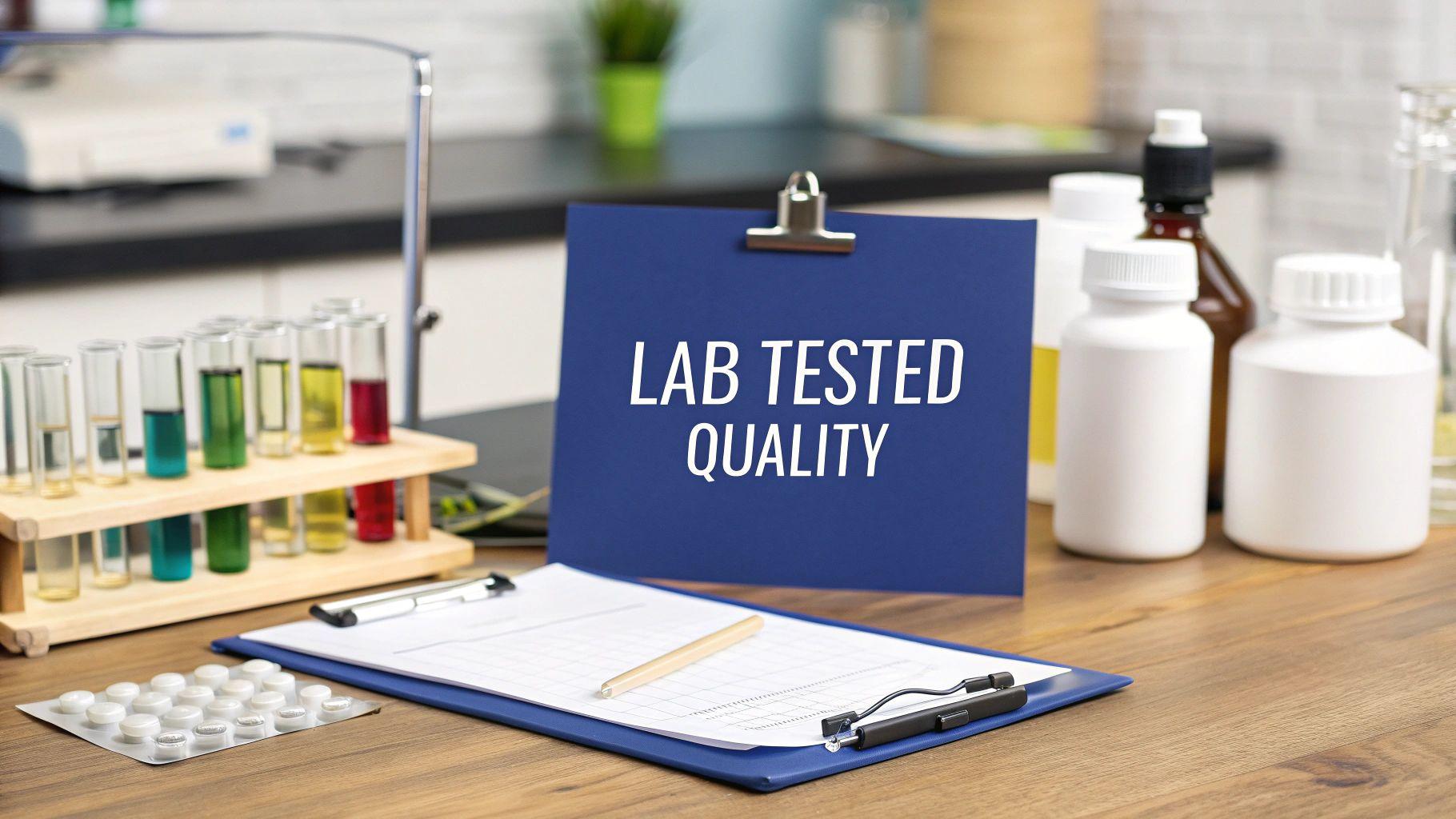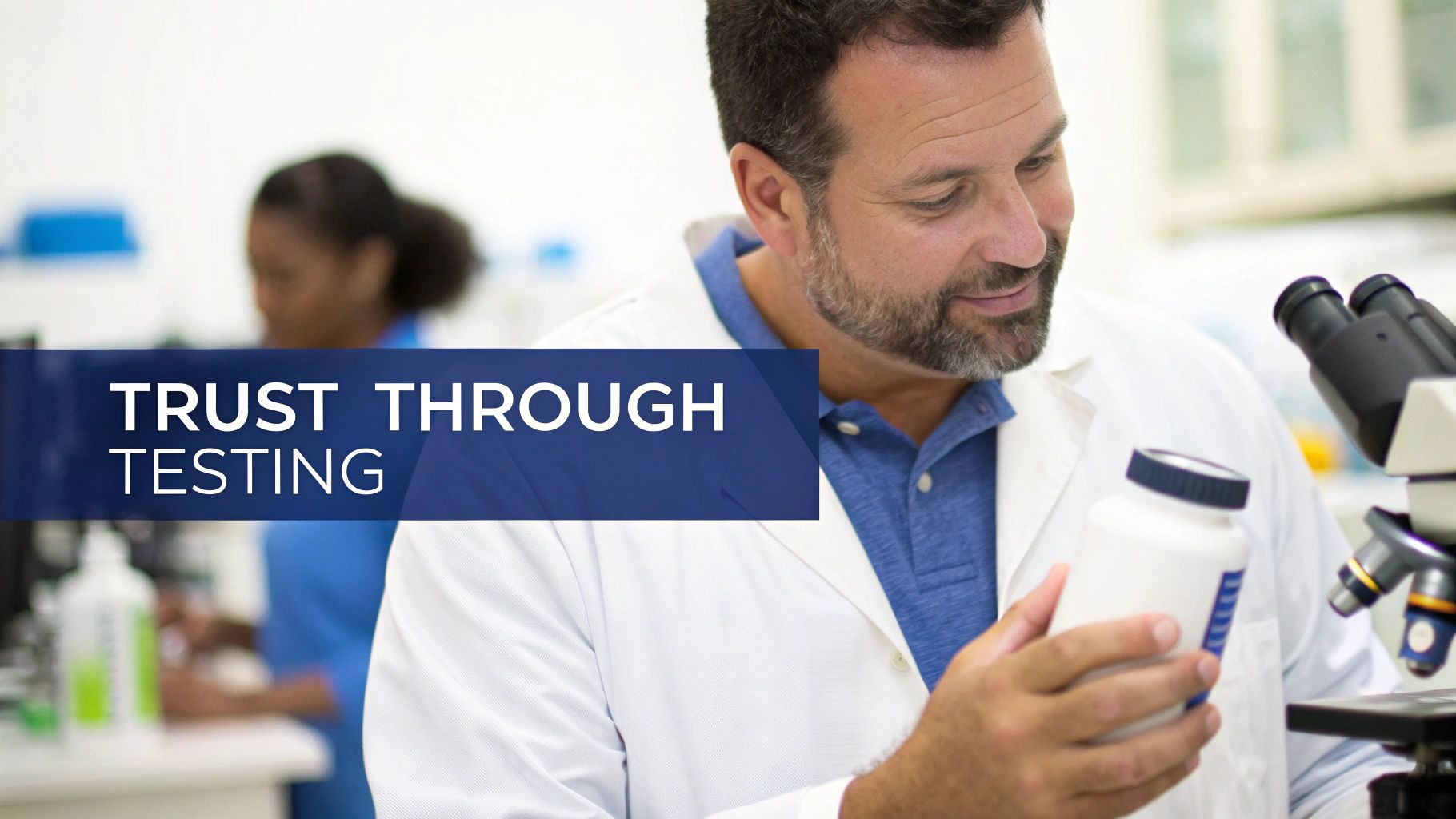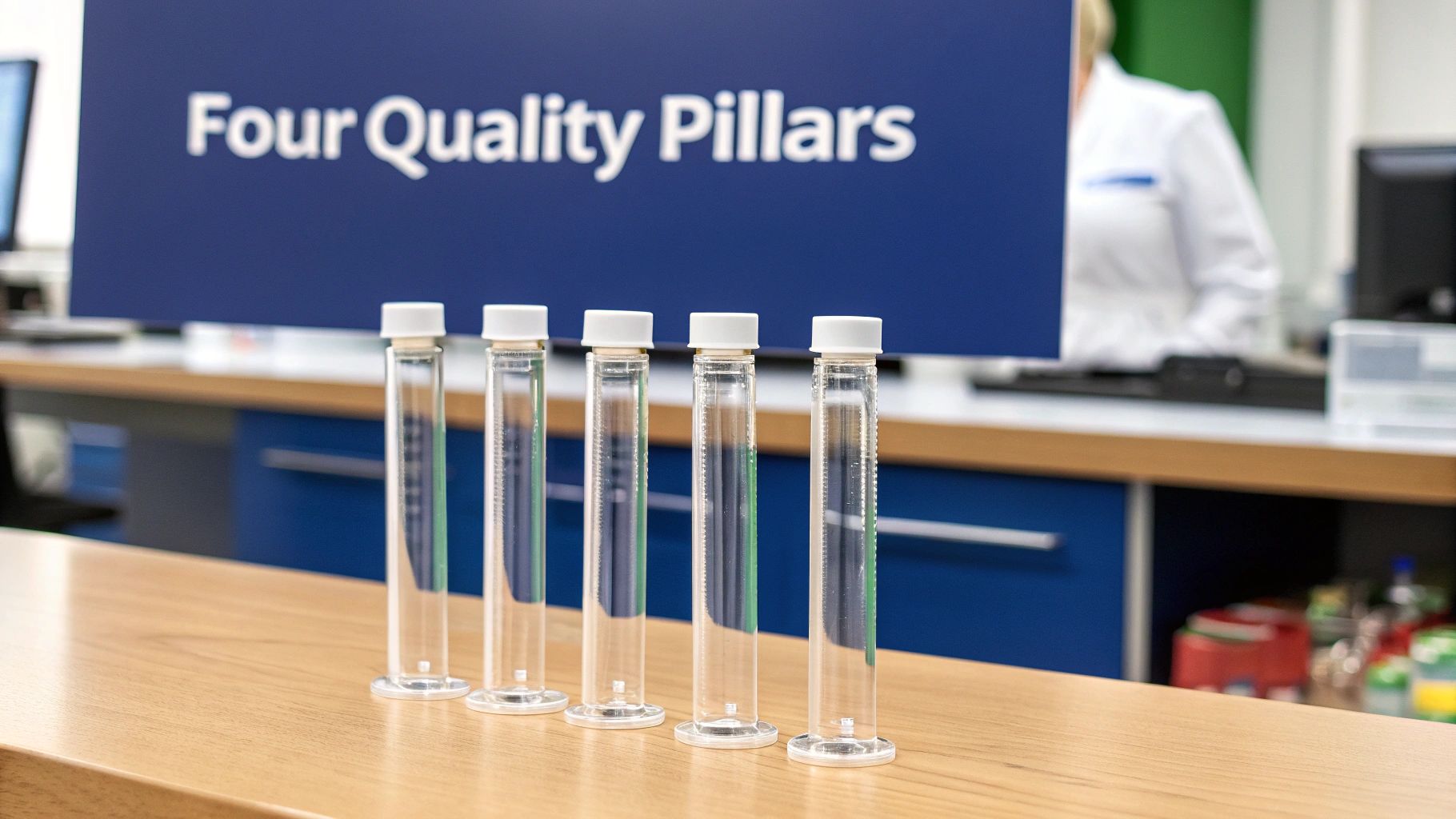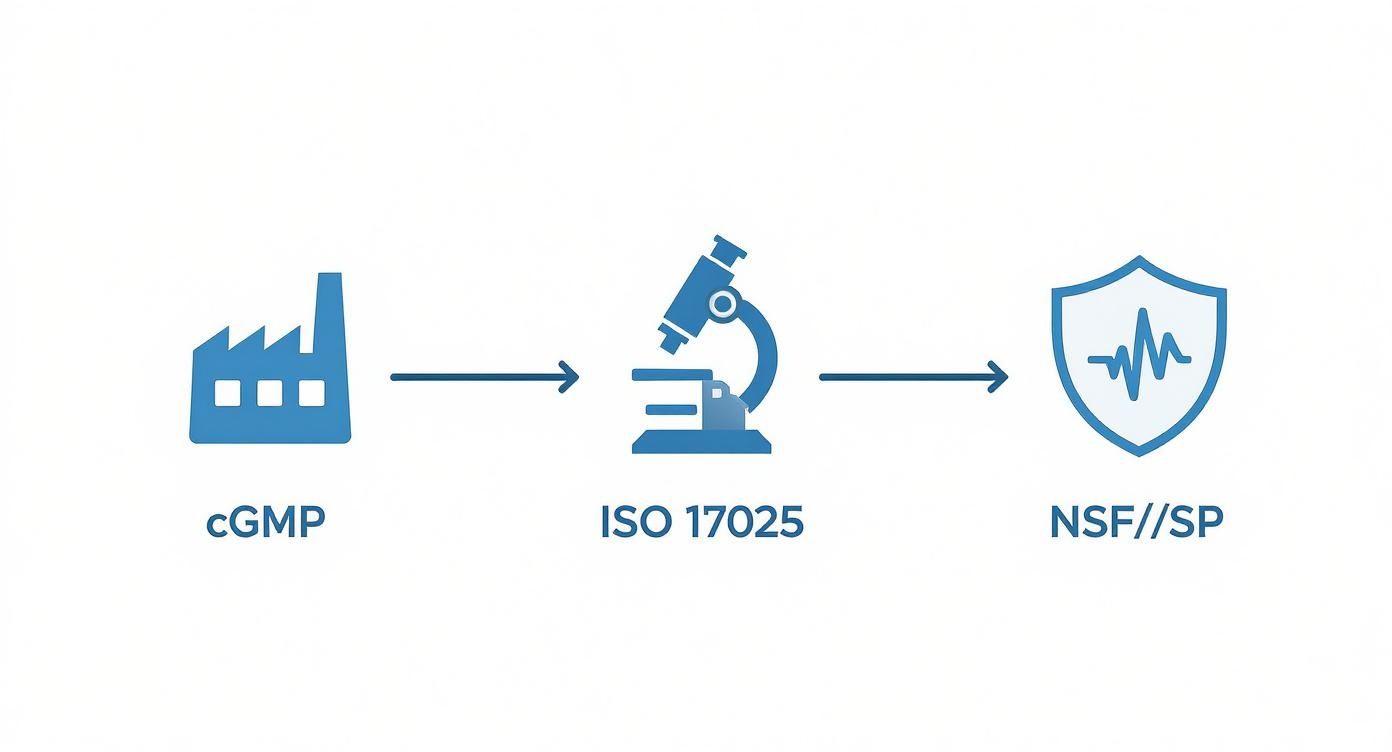A Brand's Guide to Supplement Testing Labs
Your guide to navigating supplement testing labs. Learn how to ensure product safety, build trust, and maintain compliance with third-party testing and COAs.
 Get a Free Quote Today!
Get a Free Quote Today!For a modern wellness brand, especially in the fast-growing liquid herbal space, partnering with the right supplement testing lab isn’t just a compliance checkbox—it's the bedrock of your brand. Third-party verification is what substantiates the promises on your label. It’s what transforms quality assurance from a cost center into your most powerful tool for building customer trust and long-term success. As your R&D partner, we guide you through this critical process from concept through launch.
Why Testing Is Your Brand’s Strongest Asset

In a crowded market, trust is the only currency that matters. Your customers expect a product that is not only effective but, above all, safe. Independent testing provides the unbiased, hard evidence you need to build that unbreakable bond.
Think of it this way: your label makes a promise. A Certificate of Analysis (COA) from a reputable lab is the verifiable, third-party proof that you’ve kept it. This single document is your shield, protecting your brand from the very real risks of cutting corners.
The High Stakes of Inadequate Testing
Without a rock-solid testing program, you’re walking a tightrope without a net. The risks aren't just hypothetical; they are real-world business threats that trip up brands every day.
- Retailer Rejection: Major players like Amazon and Walmart have strict compliance requirements. Fail to provide valid COAs from a certified lab, and you face immediate product delisting, frozen inventory, and suspended accounts.
- Brand Damage: In an age of instant online reviews and social media, a single quality issue can cause devastating and permanent harm to your reputation.
- Regulatory Scrutiny: Not complying with cGMP (Current Good Manufacturing Practices) in our FDA-registered facility is like waving a red flag at regulators. It can lead to expensive recalls or, worse, serious legal action.
For businesses running health supplements Shopify stores, proving product quality through testing isn't just good practice—it's the foundation upon which customer loyalty is built.
Turning Quality Control Into a Marketing Advantage
When you see supplement testing labs as strategic partners, the entire dynamic shifts. A solid testing strategy becomes a powerful marketing tool and a key differentiator. Our transparent timelines and on-time delivery record ensure you can build your marketing campaigns with confidence.
The demand for this level of transparency is booming. The global dietary supplements testing market was pegged at USD 2,219 million in 2024 and is expected to rocket to over USD 3.6 billion by 2030. This explosive growth is driven by savvy consumers and tougher regulations that demand proof of quality.
By investing in comprehensive third-party testing, you aren't just buying data—you are investing in a defensible quality story. This story empowers your marketing, justifies premium pricing, and fosters a loyal customer base that chooses your brand with confidence.
Ultimately, a proactive approach to supplement quality control is the cornerstone of any thriving wellness business. It secures your market access, builds lasting trust, and ensures your brand's integrity stands strong.
The Four Pillars of Supplement Quality Testing

Understanding what happens inside a supplement testing lab is simple when you break it down into four core pillars. These are the non-negotiable quality checks for every batch of your product, from pilot runs to full-scale production.
Each pillar answers a fundamental question your customers are trusting you to get right. Grasping these concepts allows you to have more productive conversations with your manufacturing partner. You’ll go from passively accepting a Certificate of Analysis (COA) to actively understanding the story it tells about your product’s integrity.
Pillar 1: Identity and Potency
First: does your product actually have the ingredients listed on the label, and are they present in the right amounts? This is the heart of your brand promise. Identity and potency testing confirms you’re delivering on that promise.
For instance, if your liquid elderberry tincture advertises 500mg of elderberry extract per serving, potency testing verifies that number. Identity testing, often using sophisticated methods like High-Performance Liquid Chromatography (HPLC), is like a botanical fingerprint analysis. It confirms the extract is genuinely from elderberry and not a cheaper look-alike.
This isn't just about label accuracy; it's about efficacy. A product that fails a potency test won't deliver the results your customers expect—a fast track to negative reviews and shattered trust. This pillar ensures your product works as intended.
Pillar 2: Purity and Contaminants
Once you’ve confirmed what’s in your supplement, the next critical step is to prove what isn’t. Purity testing screens for unwanted and potentially harmful substances. A reputable supplement testing lab is your first line of defense against these invisible threats.
The main culprits labs look for include:
- Heavy Metals: Lead, mercury, arsenic, and cadmium can accumulate in the body and pose serious long-term health risks.
- Pesticides and Herbicides: These can find their way into raw botanicals if you aren't sourcing from high-quality, verified suppliers.
- Solvent Residues: If harsh chemicals are used during extraction, trace amounts can remain in the final product. As your partner, we leverage advanced, temperature-controlled botanical extraction methods to minimize this risk from the start.
A clean purity test is a powerful statement. It tells the world you’re serious about premium raw materials and superior manufacturing processes.
Pillar 3: Microbiology
This pillar tackles product safety from a microbial standpoint. In short, microbiological testing hunts for harmful microorganisms like bacteria, mold, yeast, and pathogens such as E. coli and Salmonella. For liquid supplements, this step is absolutely non-negotiable.
Think of it as a microscopic safety inspection. Contamination can happen anywhere, from raw ingredients to the bottling line, which is why our innovative cold-fill technology is designed to enhance microbial safety. Failing a microbial test means a batch is unsafe and must be destroyed. It's a critical safety gate that protects your customers and shields your brand from a devastating recall.
Pillar 4: Stability and Shelf Life
Finally, stability testing ensures your product remains safe and potent all the way to its expiration date. This isn't a one-off test. It's a process that analyzes how your custom formula holds up over time when exposed to different conditions, like changes in temperature and humidity.
The goal is to answer a simple question: will the product on a shelf six months from now be just as effective as the day it was made? Stability data confirms potency doesn’t degrade and that no microbial growth occurs during the product’s intended shelf life. This testing provides the scientific proof for the "best by" date on your bottle, giving retailers and customers confidence in your product's quality and longevity.
To make these concepts even clearer, here’s a quick-reference table.
Core Supplement Testing Types and Their Purpose
| Test Category | What It Analyzes | Why It's Critical for Your Brand |
|---|---|---|
| Identity & Potency | Confirms the active ingredients are correct and present at the strength stated on the label. | Builds trust and ensures your product is effective. This is the foundation of your promise to the customer. |
| Purity & Contaminants | Screens for heavy metals (lead, arsenic), pesticides, and residual solvents from extraction. | Protects consumers from harmful substances and demonstrates your commitment to clean, high-quality sourcing. |
| Microbiology | Checks for harmful bacteria (E. coli, Salmonella), yeast, and mold. | A non-negotiable safety check that prevents illness, protects public health, and avoids costly product recalls. |
| Stability & Shelf Life | Evaluates how the product's potency and safety hold up over time under various conditions. | Justifies the expiration date on your packaging, ensuring the product remains effective for its entire shelf life. |
Understanding these four pillars is the first major step toward mastering quality control and building a supplement brand that people trust for the long haul.
Understanding Key Lab Certifications and Standards
Making sense of supplement testing labs can feel like drowning in alphabet soup. But for you, the brand owner, these certifications aren't just jargon—they are the language of quality. They draw a clear line between a competent, legitimate lab and one that could put your brand at risk.
Think of it this way: choosing a lab is like choosing a business partner. You want their standards to mirror your own. These logos aren't for show; they're hard-earned proof that a lab’s processes, equipment, and team can produce accurate, reliable, and legally defensible results. They are your first and most important filter.
ISO/IEC 17025: The Gold Standard for Technical Competence
If there's one non-negotiable certification for a supplement testing lab, it's ISO/IEC 17025. This is the international gold standard for the technical competence of testing labs. It's far more rigorous than the common ISO 9001, which only covers general quality management. ISO/IEC 17025 proves a lab actually knows what it's doing.
A lab with ISO/IEC 17025 accreditation has demonstrated it can:
- Consistently produce precise and accurate test data.
- Operate a robust quality management system designed specifically for lab work.
- Maintain properly calibrated equipment and use validated testing methods.
A lab with this accreditation has passed a rigorous third-party audit of its technical capabilities. For major retailers like Amazon, a COA from an ISO/IEC 17025 accredited lab isn't a suggestion—it's a requirement. It’s your guarantee that the numbers on that report are trustworthy.
cGMP Compliance: The Foundation of Quality Manufacturing
While ISO/IEC 17025 is about the lab, cGMP (Current Good Manufacturing Practices) governs the entire manufacturing environment. Enforced by the FDA, these are the rules that ensure products are consistently produced and controlled according to strict quality protocols. Your manufacturer's facility must be cGMP compliant and UL certified, and so should any third-party lab you hire.
A lab that is cGMP compliant demonstrates it operates with the same quality mindset required of your production facility. This alignment is vital. It ensures every step, from handling raw materials to final product testing, adheres to the highest industry standards. For a deeper dive, our guide on what a GMP certificate means for your brand is a must-read.
NSF, USP, and Other Key Certifications
Beyond the foundational ISO and cGMP standards, other certifications signal a lab’s specific expertise. These can be powerful differentiators, especially for brands targeting discerning consumers or athletes.
Here are a few others you’ll encounter:
- NSF International: A highly respected independent organization. An NSF seal is a strong signal to consumers that a product has been rigorously tested for quality and safety.
- USP (United States Pharmacopeia): The USP sets official quality standards for supplements. When a lab uses USP-verified methods, they are following science-based, officially recognized testing protocols.
- AOAC INTERNATIONAL (Association of Official Analytical Collaboration): This group develops and validates analytical methods used worldwide. If a lab uses AOAC Official Methods of Analysis (OMA), it’s using globally recognized, high-confidence procedures.
Ultimately, this collection of certifications paints a complete picture of a lab’s capabilities. By understanding what they mean, you can confidently vet potential supplement testing labs and choose a partner that truly backs up your brand’s commitment to quality.
How to Read a Certificate of Analysis (COA)
The Certificate of Analysis (COA) is your product’s official report card. At first glance, it can look dense and intimidating. But for a brand owner, it's one of the most powerful tools you have to verify the quality, safety, and integrity of your product.
Learning to read a COA confidently is a non-negotiable skill. It turns a complex lab report into a clear confirmation that what you’re selling matches the promises on your label. This document is your proof, your defense, and a testament to your commitment to quality.
Decoding the Essential Sections of a COA
A COA isn't as complicated as it looks. It has a few key sections, each telling a specific part of your product’s story. You don’t need to be a chemist to pull out the critical information.
Here’s a breakdown of the must-know components on any COA from a credible supplement testing lab:
- Header and Product Information: This is the "who and what" section at the top. You should immediately see the lab's name, your product’s name, and, most importantly, the Lot Number or Batch Number. This number is your golden thread; it links this specific test report to a unique production run, ensuring complete traceability.
- Sample and Test Details: This area provides context, including the date the sample was received and the date the analysis was completed. It’s all part of the chain-of-custody that confirms the sample's integrity.
- The Analysis Table: This is the heart of the COA—it’s where the data lives. It's usually a simple table organized into columns that detail the specific tests performed and what the lab found.
This infographic shows how foundational certifications from governing bodies like cGMP, ISO, and NSF/USP ensure the reliability of the data you see on a COA.
 These standards create a system of checks and balances, proving that the lab generating your COA is technically competent and follows strict, non-negotiable quality protocols.
These standards create a system of checks and balances, proving that the lab generating your COA is technically competent and follows strict, non-negotiable quality protocols.
Interpreting the Results Like an Expert
The analysis table is where the action is. While the layout might vary, the columns almost always include the same key pieces of information. Let’s break them down.
- Test/Analyte: This column lists exactly what was tested, such as an active ingredient ("Elderberry Anthocyanins"), a heavy metal contaminant ("Lead"), or a microbe ("Total Aerobic Bacteria").
- Specification/Limit: This is your brand's quality standard—the acceptable range or limit. For potency, it might be "≥ 500 mg/serving." For a contaminant like lead, it might be "< 10 ppm" (parts per million). These are the benchmarks you and your manufacturing partner agreed upon.
- Result: This column shows the actual, measured value from the lab test. This is the moment of truth.
- Method: This tells you the scientific method used for the analysis (e.g., HPLC, ICP-MS). Seeing a validated, industry-standard method adds another layer of confidence.
- Pass/Fail: This is the final verdict—a quick summary that tells you if the result for each test met the specification.
When reviewing a COA, your primary job is to compare the 'Result' column directly against the 'Specification' column. For every single line item, the result must meet the standard. No exceptions.
Understanding Common Lab Terminology
As you scan the results, you’ll encounter a few common acronyms. Knowing what they mean is key.
- CFU/g (Colony Forming Units per gram): This unit appears in microbiology testing to quantify microbes. Your specification will set an upper limit, for example, "< 100 CFU/g."
- < LOQ (Less Than Limit of Quantitation): Seeing this on a contaminant test is a great sign. It means the substance wasn’t detected at a level the lab’s equipment can reliably measure. In plain English: "not found."
- ND (Not Detected): Similar to < LOQ, this simply means the analyte was not found.
By getting comfortable with these key sections and terms, you can quickly and effectively review any COA. This simple act of verification is a cornerstone of responsible brand management, ensuring every batch you release is safe, effective, and true to your word.
In-House vs. Third-Party Labs: Which Path Is Right for You?
As a brand owner, a key strategic call is whether to rely on your manufacturer's in-house lab or engage an independent, third-party lab for verification. This decision shapes your brand's credibility, manages risk, and builds customer trust.
An in-house lab, located right on the production floor, offers one huge advantage: speed. Samples can be tested on the spot, streamlining quality control and shortening lead times. This is a big win for routine, in-process checks.
But that convenience comes with a potential conflict of interest. While many in-house labs do great work, you're ultimately asking the company that makes your product to grade their own homework. This can create a shadow of bias, whether real or perceived.
The Power of Independent Verification
This is where independent, third-party supplement testing labs are essential. Their sole purpose is to provide objective, unbiased, and legally defensible data. When a third-party lab signs a Certificate of Analysis (COA), it carries significant weight because they have no stake in the outcome beyond accuracy.
That impartiality is your brand's best armor. It proves to customers, retailers like Amazon, and regulators that you are committed to transparency. In a flooded market, that's a powerful way to stand out.
Using a third-party lab isn't about distrusting your manufacturer; it's about verifying quality through an impartial system of checks and balances. This investment in unbiased proof is what transforms a good product into a trustworthy brand.
This move toward independent testing isn't just a niche trend—it's the industry standard. North America dominates the dietary supplement testing space, with the United States and Canada holding a massive combined market share of 89.2% in 2024. This shows just how central third-party verification has become, with independent labs driving this new ecosystem of quality.
Making the Smart Choice for Your Brand
So, what's the right move? For most successful brands, the answer is a hybrid model that gives you the best of both worlds.
Let your manufacturer's in-house lab handle the rapid, in-process checks that keep production moving efficiently. Then, send your finished batches to a trusted third-party lab for the final, official verification. This strategy delivers both speed and rock-solid credibility. To learn more, check out our guide on the benefits of third-party supplement testing.
When vetting a manufacturing partner, dig into their lab capabilities. Their answers will reveal their true commitment to quality.
Here’s a simple checklist for that conversation:
- What certifications does your in-house lab hold? The only answer you want to hear is ISO/IEC 17025 accreditation. Consider it non-negotiable.
- Can you provide third-party COAs for recent batches? A confident partner will have no problem showing proof of external verification.
- What is your process for an out-of-specification (OOS) result? A great partner will have a clear, documented process for investigating and resolving any test failures.
- Can we send finished products to our own lab for verification? The answer should be an immediate "yes!" A true collaborator welcomes that extra layer of accountability.
Frequently Asked Questions About Supplement Testing
Stepping into the world of supplement testing can bring up a lot of questions. Here are clear, straightforward answers to the most common ones we hear from entrepreneurs and brand managers, so you can work with supplement testing labs with confidence.
What Does Supplement Testing Typically Cost?
There’s no single price tag for testing. A simple microbial panel might cost a few hundred dollars per batch. A comprehensive workup covering potency, heavy metals, and stability studies could be several thousand.
Think of testing as a core, non-negotiable part of your production budget. Always ask for an itemized quote from any lab you consider. A good lab will be transparent with their pricing and help you build a testing package that makes sense for your specific product and budget.
What Are the Requirements for Selling on Amazon?
Selling supplements on major marketplaces like Amazon is a high-stakes game with strict compliance rules. You are required to provide a Certificate of Analysis (COA) for your product. Critically, that COA must come from an ISO/IEC 17025 accredited laboratory. This is a hard requirement, not a suggestion.
Additionally, Amazon demands proof that your product was made in a cGMP (Current Good Manufacturing Practices) compliant facility. All of your documentation must be current, accurate, and ready to submit instantly. Failure to comply risks suspended listings, frozen inventory, or even a full account shutdown.
How Do I Choose the Right Supplement Testing Lab?
Picking a lab is about finding a true partner in quality who is as invested in your brand’s integrity as you are.
Here are four make-or-break criteria:
- Confirm ISO/IEC 17025 Accreditation: This is your first filter. This certification is the global gold standard for technical competence.
- Verify Relevant Experience: Does the lab have a deep history with your specific product type, such as liquid herbal extracts? Ensure they know your turf.
- Inquire About Testing Methods: Get specific. Ask what technology they use. For potency, you want to hear them say HPLC (High-Performance Liquid Chromatography), the industry benchmark for accuracy.
- Evaluate Their Partnership Potential: How do they communicate? Are their reports easy to understand? Do they answer your questions clearly? A great lab acts like a collaborator, not a black box.
Treat this process like hiring a key team member. You need competence, but you also need a partner who shares your commitment to excellence.
What Is a Chain of Custody and Why Does It Matter?
A Chain of Custody is the formal paper trail that documents your sample’s journey from the moment it leaves your facility to its final analysis at the lab.
Why is this so important? It guarantees the sample’s integrity. It's proof that the sample tested is the exact same one you sent—uncontaminated, unswapped, and untampered with. This ensures the results on your COA are exclusively for your product batch.
A strong Chain of Custody makes your test results legally defensible. It creates an undeniable link between the physical sample and the data on your Certificate of Analysis, adding a critical layer of regulatory proof and legal weight to your quality program.
Any reputable lab will provide clear instructions and forms to make this process foolproof. Following their protocol is an essential practice that protects your brand.
Ready to create a liquid supplement backed by transparent, third-party testing? At Triton Nutra Group, we are your R&D partner from concept through launch, ensuring your product meets the highest standards for quality, safety, and compliance. We offer flexible run sizes and rapid turnaround times to get you to market faster. Request a free quote today and let's build your brand on a foundation of trust.